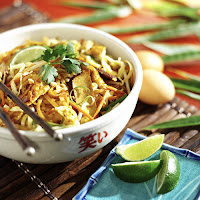
A busier week than I predicted didn't allow me to catch up on my recorded shows until last night, including Wednesday night's "Too Young To Be So Fat" on TLC.
The documentary, part of the "My Shocking Story" series, follows three obese teenagers.
Dexter is 16 and weighs 340 pounds.
Corina is 13 and weighs 230 pounds (she is three times the size of an average 13 year old girl).
Garrett is 14 and weighs almost 400 pounds.Dexter and Garrett both enroll in the
Academy of the Sierras,
the world's only boarding school for obese teenagers.
Integrated with a regular academic curriculum covering science, history, and art are weight maintenance and eating behavior classes, recreational sports, counseling sessions, and
a daily pre-breakfast 3 mile walk.At the academy, students are put on a low-fat (20 grams a day) 1,200 calorie diet.Five weeks later,
Dexter and Garrett's BMIs decrease by twenty and thirty percent, respectively.
In that relatively short time periods, they learned the basics of eating healthy and smart. Even better,
they both enjoy the taste of healthier snacks.Corina, meanwhile, is aiming to be one of the youngest liposuction patients in the world. However, she needs to boost her blood iron levels to reduce post-surgery complications.
As the show progresses, we find that despite supplementing her diet with iron pills and multivitamins,
Corina's bloodwork does not provide the required safety net. As a result, she is unable to undergo liposuction.
WHAT I LIKED: The show demonstrated that
the only path to successful weight loss and maintenance is a gradual change in dietary habits and patterns. It goes without saying that this change must also include less calories and more physical activity, but it was through
portion awareness, tasty food, and enjoyment of healthy food that Dexter and Garrett successfully started shedding pounds.
A few scenes at the Academy of the Sierras made it clear that at this institution,
food is not an enemy. It is a friend that hasn't been discovered.
Students are not made to feel guilty about eating, nor are they told to avoid food groups altogether. Instead,
they are given skills to help them navigate the food landscape and make healthy choices.The show acknowledges that a deep emotional void lies at the root of all three subjects' obesity. I appreciated this picture of obesity as a mind-body-spirit triad.
In fact,
all three teenagers' weights began to skyrocket soon after an emotionally traumatic event (coincidentally, all three cases involved divorce or the abandonment of a parent at an early age).
In Corina's case, this facet of her obesity is fully explored.
Her mother works night and sleeps in the morning, allowing the two of them
approximately two hours a day of interaction.In turn, Corina's eating goes unmonitored.
One particularly painful segment follows Corina, her mother, and her cousin as they take
a short vacation to a nearby casino.While Corina's mother is off at the slot machines for hours, Corina and her cousin head off to the buffet.
We then see Corina, who in previous confessionals states she puts effort into eating right and losing weight but it just "doesn't work for her", pile on fried chicken, fried fish, and macaroni and cheese onto her plate.That is then followed by slices of cake and cookies.It is clear that what Corina needs is not liposuction but
a therapist and dietitian to help unravel her motivations and behaviors.One unforgettable scene has her eating grilled steak and salad, a meal she says she has never had.
Corina literally gags on a cherry tomato (first time she's ever tried one) and says her meal is disgusting!WHAT I WOULD HAVE LIKED TO SEE MORE OF: The confines of a one-hour (44 minutes without commercials) documentary tracking the lives of three separate people make it difficult to truly dig into any given "storyline."
Although we delve into Corina's psyche,
some of the other teenagers are left in the dark.In Dexter's case, we see a short in which, during parents' weekend at his school, he feels comfortable and secure enough to express his frustration with his father's overly high expectations in a family counseling session.
As far as Garrett is concerned, he admits to turning to food as an emotional refuge, but
we never see him altering -- or attempting to alter -- these coping skills.The ending of the documentary was rather abrupt.
A "six months later" followup segment would have been a treat, particularly since I was interested in all three teenagers' stories.
I was particularly intrigued to know if Corina made an effort to change her diet after she was rejected as a liposuction patient.
WHAT COULD HAVE BEEN LEFT OUT: A scene showing Garrett's grandmother visiting the Sierra Academy hinted at the teenager's truancy problems as well as issues with obeying authority.
This seemed out of place because, prior to this, Garrett was portrayed as a motivated willing participant who enjoyed his time there.
IN CONCLUSION: "Too Young To Be So Fat" takes a multi-layered look at obesity and demonstrates that
a combination of healthier eating, behavior modification, and psychological counseling provides the most effective results.Two thumbs up to TLC!
 Ugh. And so we have the first stupid trend of the year -- chewable ice!
Ugh. And so we have the first stupid trend of the year -- chewable ice!


































